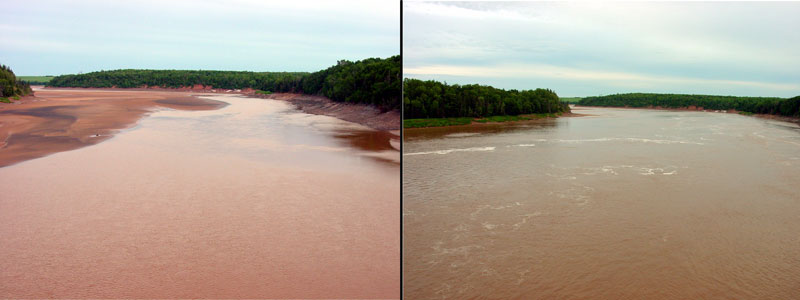
The Bay of Fundy is bounded by New Brunswick on the north and Nova Scotia on the south. It is well known for its high tides. The highest recorded tide in the world is reported to be 54 feet (the difference between high tide and low tide) and occurred at Burntcoat Head, Nova Scotia, which is on the Minas Basin, a bay on the Bay of Fundy. At Burnt coat Head the average tide is 40 feet; most of the Bay of Fundy sees tides in the range of 25 to 40 ft. Consequently, villages located on the Bay of Fundy attempt to promote these tides, and their effects, as tourist attractions.

Our first stop on the Bay of Fundy was at Maitland, Nova Scotia, which is
where the Shubenacadie River flows into Minas Basin. High tide in Minas Basin
causes a tidal bore to propagate up the Shubenacadie River. Companies promoting
white water trips on the river advertise the tidal bore to be a wall of water a
couple of feet high. We didn't see a wall of water, but the river did certainly
reverse flow. The picture on the left shows the river before reversal, with
large mud flats and sand bars. The picture on the right, taken about 45 minutes
later, shows the river much higher and flowing inland. The rate of flow was
rather impressive; it was flowing inland at least as fast as the main channel of
the Wisconsin river. This suggests a rather interesting canoe trip. You put in
before the tidal bore and canoe downstream until flow reversal occurs; then you
turn around and continue canoeing "downstream" to get back to your put in point!
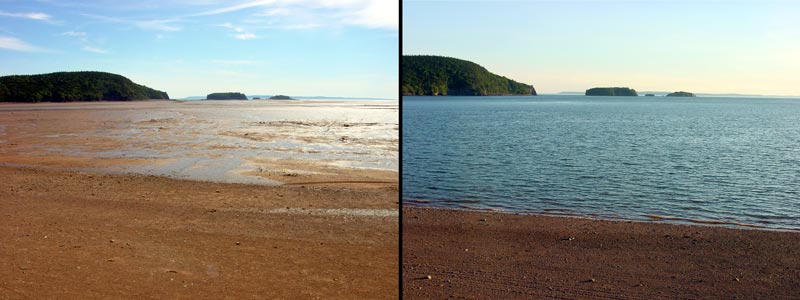
Our next stop was at Five Islands on the north shore of Minas Basin (still in
Nova Scotia). At low tide (left photo) the mud flats go way out; at high tide
(picture on the right) the water is several feet deep and motor boats cruised
through the area. We saw a lot of people out on the mud flats digging clams at
low tide. It looked too much like work to me; they spent hours bent over digging
in the mud.
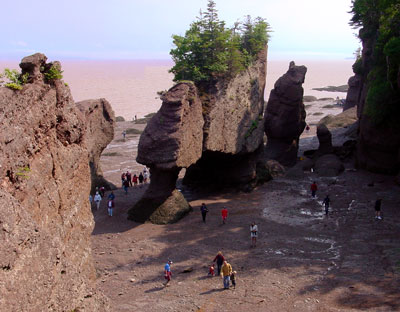
The tides of the Bay of Fundy cause some interesting erosion patterns, such
as these "flower pot" rocks at Hopewell Cape in New Brunswick. Here they are
seen at low tide; at high tide kayakers paddle around these rocks.
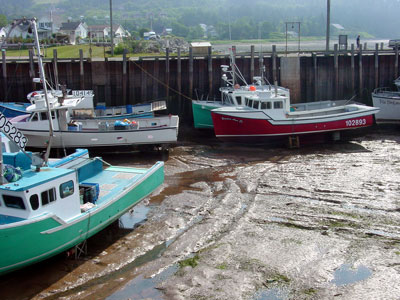
The harbor at Alma, New Brunswick, during low tide. The boats settle down on
supports as the tide ebbs, and then lift off the supports as the tide comes in.
At low tide, the mud flats extend a mile out from shore. Hence the harbor is
accessible only at high tide. This is a common feature at many Bay of Fundy
harbors.
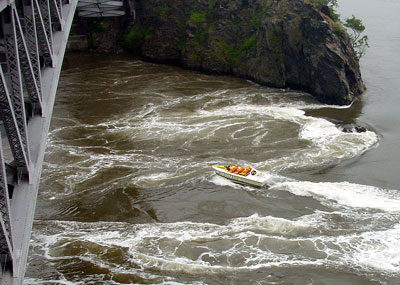
Another tourist gimmick is the "Reversing Falls" at St. John, New Brunswick.
The tide causes the St. John river to reverse flow. There are no real falls, but
underwater rocks cause rapids, which reverse direction with the tide.
Jet-powered boats will take tourists through the rapids - for a price, of
course. This picture was taken shortly after high tide; the water is flowing
inland.
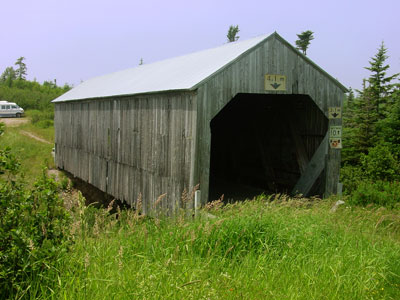
New Brunswick is also known for its covered bridges; supposedly there are
about 70 of them still left. This one is at Lepreau, west of St. John. Covered
bridges were known as "kissing bridges" in the 19th century. They provided a few
minutes of privacy and darkness to young couples out on a date, especially if
the horse pulling the carriage was trained to walk slowly through the bridge.
The next stop was Campobello Island, located in the Bay of Fundy in Canada,
but very near to Maine. In the 1880s it was a popular summer vacation location
for wealthy people from east coast cities. Franklin D. Roosevelt's parents
visited here when FDR was 1 year old and enjoyed it so much that they purchased
a summer home here. FDR spent his childhood summers here, learning to sail and
engaging in other outdoor activities, After he married Eleanor his mother gave
him the summer home next door as a wedding present. FDR and Eleanor and their
children continued to spend summers here until FDR was stricken by polio, and
the demands of political office kept him too busy. It is now an international
park in memory of FDR and administered both by Canada and the U.S. Park Service.
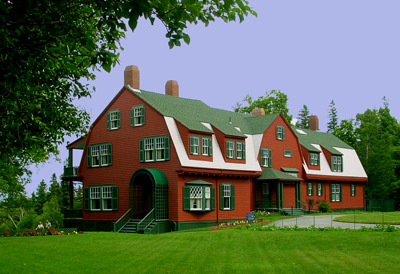
FDR and Eleanor's summer home at Campobello. The place is large, with 18
bedrooms. The home is furnished with furniture from the Roosevelt family.

The family room in the FDR home. The hat on the seat and the pipe on the table belonged to FDR. They were obviously an active, outdoors-oriented family until polio struck. FDR loved to sail and taught his children sailing. He also built a nine hole golf course across the road from the house.